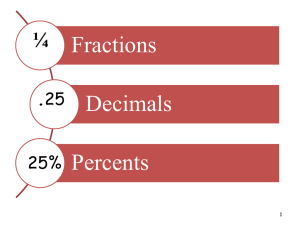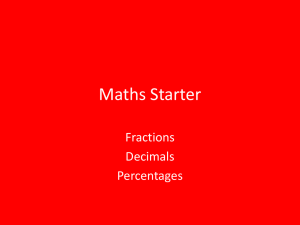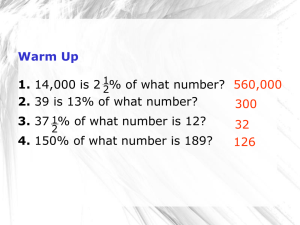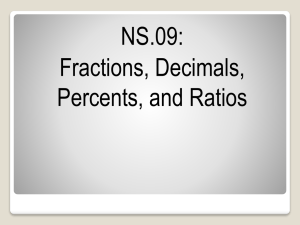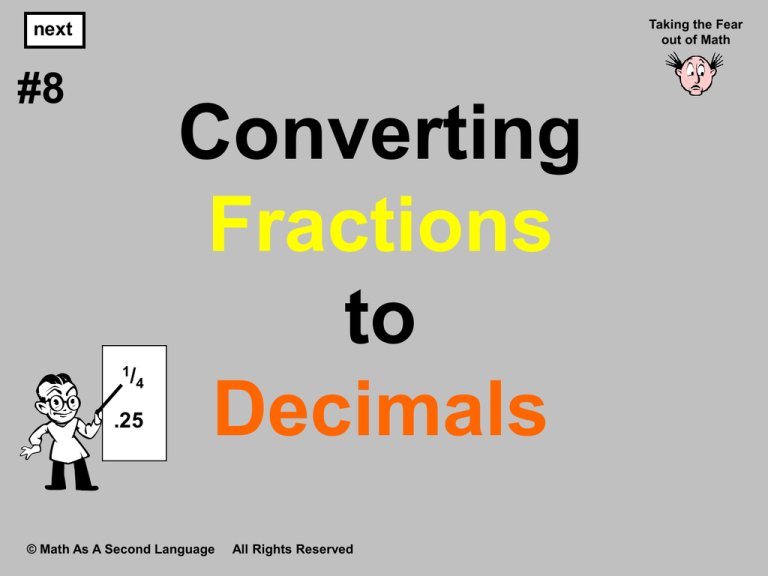
Taking the Fear
out of Math
next
#8
1/
4
.25
Converting
Fractions
to
Decimals
© Math As A Second Language
All Rights Reserved
next
The meaning of 1 ÷ 2 doesn't
depend on whether we represent
the quotient as a common fraction
or as a decimal fraction.
Independently of how we elect to
write the answer, 1 ÷ 2 means the
number that when multiplied by 2
yields 1 as the product. However,
if we elect to write the quotient as
a common fraction we use the
notation 1/2; while in the language
of decimal fractions, the quotient
is represented by 0.5.
© Math As A Second Language
All Rights Reserved
next
One possible disadvantage of using
common fractions rather than decimal
fractions is that there are many different
common fractions that name the same
rational number.
For example, while 1 ÷ 2 = 1/2, it is also
equal to 2/4, 3/6, 4/8, etc. On the other hand,
when we use decimal fractions there is
only one way to represent the quotient
note
1 ÷ 2; that is, 0.5.1
1 While 1 ÷ 2 = 0.5, it is also equal to 0.50, 0.500, etc. However, to avoid this
technicality we will agree to end the decimal representation after the last non-zero
digit. For example, we will write 0.25 rather than 0.25000, etc. This is analogous
to what we do when we use common fractions. We pick the fraction which has
been reduced to lowest terms. For example, even though 1/2 = 2 /4 , we do not
usually write that 1 ÷ 2 = 2/ 4 .
© Math As A Second Language
All Rights Reserved
next
On the other hand, using common
fractions allows us to express the quotient
of any two whole numbers rather quickly.
For example, in the language of common
fractions, 139 ÷ 201 = 139/201.
However, representing this quotient
in the form of a decimal fractions
presents a new challenge to us.
To see why, let’s see what happens
when we try to represent the quotient
5 ÷ 6 as a decimal fraction.
© Math As A Second Language
All Rights Reserved
next
As we did in an
earlier lesson we can
use the division
algorithm to obtain…
and no matter how many
0’s we use to augment
the dividend, we are
faced with the fact that
each time the algorithm
tells us that “6 goes into
20 three times with a
remainder of 2”.
© Math As A Second Language
All Rights Reserved
6
.8 3 3 3 3
5.0 0 0 0 0
48
20
18
20
18
20
18
20
18
2
next
In other words, the decimal fraction
that represents 5 ÷ 6 consists of a decimal
point followed by an 8 and an endless
number of 3’s!
In this particular example, we saw that a
problem arose when we tried to express
the common fraction 5 ÷ 6 as an
equivalent decimal fraction. Unfortunately,
this situation turns out to be the general
rule rather than the exception.
© Math As A Second Language
All Rights Reserved
next
Given two whole numbers chosen at
random, it is highly likely that the decimal
fraction that represents their quotient will
be an “endless” decimal.
The Reason Why
For the common fraction to represent
a decimal that terminates, its
denominator must be a power of 10.
© Math As A Second Language
All Rights Reserved
next
A terminating decimal must be
a whole number of tenths, hundredths, or
thousandths, etc. However, the only prime
factors of powers of 10 are 2 and 5. So as
long as the divisor (i.e., the denominator)
consists of only 2’s and/or 5’s as prime
factors, the decimal representation will
eventually terminate. But, if the divisor has
even one prime factor other than 2’s and
5’s, the decimal representation will never
come to an end.
© Math As A Second Language
All Rights Reserved
next
Illustrative Example #1
Let’s express 3/8 as an equivalent
common fraction whose denominator is
a power of 10.…
We may “decompose” 8 into a product of
prime factors by writing it as 2 × 2 × 2.
If we multiply 2 by 5, we get 10, and if we
multiply each of the three 2’s by 5, we get 103
(or 1,000) which is, of course, a power of 10.
© Math As A Second Language
All Rights Reserved
next
Specifically…
2×2×2×5×5×5
(2 × 5) × (2 × 5) × (2 × 5) = 10 × 10 ×10 =
103
However, if we multiply the denominator of
a fraction by 5 × 5 × 5, we must also
multiply the numerator by 5 × 5 × 5;
otherwise we change the value of the
fraction.
We may rewrite 3/8
3×5×5×5
375
= 1,000
2
×
2
×
2
×
5
×
5
×
5
in the form…
or as a decimal…
= .375
© Math As A Second Language
All Rights Reserved
next
Notes
► We could again
have obtained the same
result by long division.
0 .0 7 5
40 3.0 0 0
280
200
200
0
► Once again notice that we
finally arrived at a point
where the remainder was 0.
© Math As A Second Language
All Rights Reserved
next
Notes
► Using the adjective/noun theme we
see that 3.000 ÷ 40 is equivalent to
3,000 thousandths ÷ 40. And knowing
that 3,000 ÷ 40 = 75, we see that…
3,000 thousandths ÷ 40 = 75 thousandths
= 0.0752
note
2 Notice the importance of using the 0's as place holders. More
specifically, 0.075 is quite a bit different from both 0.75 (which is the
correct answer to 3 ÷ 4) and 0.0075 (which is the answer to 3 ÷ 400).
© Math As A Second Language
All Rights Reserved
next
Summary
A decimal is said to terminate if it has a
last non-zero digit.
--- Another way of saying this is to say that
beyond a certain number of places, the
decimal has an endless number of 0’s.
--- What we have shown in this problem is
that the fraction can 3/8 be represented by
the terminating decimal 0.375
(as well as 0.3750, 0.37500, etc.).
© Math As A Second Language
All Rights Reserved
next
--- The important thing is that in order
for a fraction to be represented by a
terminating decimal, it must be equivalent to
a common fraction, whose denominator
written in lowest terms, is a power of 10.
--- However, the only prime numbers that
are factors of 10 are 2 and 5.
--- When written in lowest terms, if a
common fraction has a prime factor other
than 2 and/or 5, it will never be equivalent
to a fraction whose denominator is a
power of 10.
© Math As A Second Language
All Rights Reserved
next
One might think that since we can write
as many 0’s as we wish after the decimal
point that we are eventually bound to come
to a place where the decimal will terminate.
Unfortunately, as we mentioned earlier, this
will happen only if the denominator has no
prime factors other than 2 and/or 5.
To get an idea of what happens if
the denominator does contain a prime
factor other than 2 or 5, let’s look at the
following example.
© Math As A Second Language
All Rights Reserved
next
Illustrative Example #2
Is there a common fraction whose
denominator is a power of 10 that is
equivalent to the common fraction 1/3 ?
One way to answer this question is to recall
that a number is divisible by 3 if and only if
the sum of it's digits is divisible by 3.
Since any power of 10 has as its digits a 1
followed only by 0’s, the sum of its digits
will always be 1 and never divisible by 3.
© Math As A Second Language
All Rights Reserved
next
The Importance of Lowest Terms
When we talk about common fractions
we will always assume (unless
specifically stated to the contrary) that
they are expressed in lowest terms.
For example, the denominator of 3/6 is 6;
which has a prime factor other than 2 or 5.
However, if we reduce it to lowest terms, it
becomes 1/2 which is represented by the
terminating decimal 0.5.
© Math As A Second Language
All Rights Reserved
next
0 .3 3 3
3 1.0 0 0
9
10
9
This process shows us that
10
9
at each step in the division
process, we are saying “3 goes
1
into 10 three times with a remainder
of 1”. Thus, no matter how many places
to the right we extended our quotient, there
would always be a remainder of 1, and
never a remainder of 0.
Another way is to think
in terms of decimal
fractions...
© Math As A Second Language
All Rights Reserved
next
The fact that there are many more
numbers whose prime factorization contains
prime numbers other than 2’s and or 5’s
means that when we express rational numbers
as decimal fractions, the decimals will most
likely be non-terminating.3
Keep in mind that our above remarks are
based on the fraction being expressed in
lowest terms. Otherwise this could lead to
a misinterpretation. For example…
note
3 For example, if we look at the whole numbers that are greater than 1 but less than
100, we see that only 1, 2, 4, 5, 8, 10, 16, 20, 25, 32, 40, 50, 64, 80, and 100 have no
other prime factors other than just 2's and/or 5’s.
© Math As A Second Language
All Rights Reserved
next
Illustrative Example #3
True or False…
We notice that the denominator of 9/15
has a prime factor other than 2 and/or 5
(ie. 3). Therefore, the decimal representation
for 9/15 must be a non-repeating decimal.
This can be a bit tricky, but the statement
is false. Namely, the denominator has a
factor other than 2 or 5. However, the
fraction is not in lowest terms.
© Math As A Second Language
All Rights Reserved
next
In fact, we can cancel the common
factor 3 from the numerator and
denominator and see that…
9
3
6
3×2
=
=
=
= 0.6
15
5
10
5×2
However, if the fraction is in lowest terms
and its denominator is 15, then, as shown
in the following example, it’s decimal
representation will not terminate.
© Math As A Second Language
All Rights Reserved
next
Illustrative Example #4
Let’s show that the decimal fraction that is
equivalent to the common fraction 2/15
doesn’t terminate.
This time the fraction is in lowest terms.
Therefore, since any power of 10 has only
2’s and/or 5’s as prime factors, 15, which
contains 3 as a prime factor, can never be a
divisor of any power of 10.
© Math As A Second Language
All Rights Reserved
next
Notes
We could have gone
directly to the division
algorithm and obtained…
0 .1 3 3
15 2.0 0 0
15
50
45
50
45
5
It soon becomes clear that we can go on
“forever” saying “15 goes into
50 three times with a remainder of 5”.
© Math As A Second Language
All Rights Reserved
next
Notes
► This leads in a natural way into a
more general discussion.
More specifically, when we tried to write
1/ as a decimal fraction, we saw that the
3
division yielded an endless sequence
of 3’s. When we tried to write 2/15 as
a decimal fraction, we saw that after
the digit in the tenths place (namely, 1) we
again obtained an endless
sequence of 3’s.
© Math As A Second Language
All Rights Reserved
next
So the question becomes “Is it always
true that when any rational number is
written in decimal form, the decimal will
either terminate or else it will eventually
repeat the same cycle of digits endlessly.4
Let’s see what happens when we try to
represent 6/7 as a decimal fraction.
note
4 In fact, if we think of all terminating decimals as eventually repeating 0’s
endlessly we may say that all rational numbers can be expressed as
non-terminating, repeating decimals.
© Math As A Second Language
All Rights Reserved
next
0 .8 5 7 1 4 2
7 6.0 0 0 0 0 0 0 0
56
40
3
5
Notice that when we started
5
0
the division process our
49
dividend was a 6 followed
10
by nothing but 0’s, and after the
7
30
sixth decimal digit our dividend
was again a 6 followed by nothing 2 8
20
but 0’s. Hence, the cycle of digits
14
“857142” will repeat endlessly.
60
Using the division
algorithm
we obtain…
© Math As A Second Language
All Rights Reserved
next
It is not just a coincidence that in the
two examples we picked in which the
decimal fraction did not terminate, the
decimal eventually repeated the
same cycle of digits endlessly.
The proof is actually quite elementary.
It is based on what is known as the
Dedekind “Chest-of-Drawers” Principle.
The example below gives a specific
application of the principle and why it
has the name that it does!
© Math As A Second Language
All Rights Reserved
next
Illustrative Example #5
Imagine that in a bureau drawer there are
100 separate white socks and 100 separate
red socks. The room is dark and you want
to make sure that you pick a matched pair
of socks (that is, either 2 white socks or 2
red socks). What is the least number of
socks that you can take out of the drawer
and still be sure that you have such a pair?
© Math As A Second Language
All Rights Reserved
next
If all you took were 2 socks you might
have a matched pair but you may also
have picked one white and one red sock
from the drawer. It’s possible that the first
two socks you picked gave you a matched
pair. However if this wasn’t the case, it
means that you have chosen one white
and one red sock. Therefore, since the
next sock you choose must be either
white or red, you will then have either a
red pair or a white pair.
© Math As A Second Language
All Rights Reserved
next
The point is that since there are only
two colors, you are guaranteed to have a
matched pair if you pick any three socks.5
This simple illustration is a form of
Dedekind’s “Chest-of-Drawers” Principle
which states... If you have more items
than you have drawers to put them in, at
least one of the drawers must hold more
than 1 item (actually, all of the items could
be in the same drawer, but at least two of
note
them must be).
5 Notice that we aren't saying what color the matched pair is. It would be quite
different if we had said “What is the least number of socks you can take
from the drawer to make sure that you have a white pair?”.
© Math As A Second Language
All Rights Reserved
next
Let’s now apply this idea to converting
common fractions into decimals.
In particular, let’s revisit the case of 1/3.
When we divide a number by 3 there are
3 possible remainders; either 0, 1, or 2.6
The “Chest-of-Drawers” Principle applies
to any denominator we may be using.
note
6 An easy way to see this is to think of packing books into cartons, each of which
holds 3 books. When all the books are packed, there can be either none,
1, or 2 books left because if there were at least 3 books left,
we could have filled another carton.
© Math As A Second Language
All Rights Reserved
next
For example, if there were 7 books in
a carton, when all the books were packed,
there could be at most 6 books left
because if there were 7 we could have
filled another carton. That is, when we
divide a whole number by 7, there are 7
possible remainders; 0, 1, 2, 3, 4, 5, or 6.7
note
7 Be careful here, there are not 6 remainders but 7. There are 6 whole numbers
between (and including) 1 and 6, but there are 7 whole numbers
between 0 and 6.
© Math As A Second Language
All Rights Reserved
next
In general, when we divide a number by
any non-zero whole number n, there are n,
possible remainders. Hence, when we
write the common fraction m/n as a decimal
fraction, the decimal part must begin to
repeat no later than by the time we get past
the nth place in the decimal.
The fact that the decimal fraction that
represents a rational number eventually
repeats the same cycle of digits gives us a
nice way to write such a decimal.
© Math As A Second Language
All Rights Reserved
next
We simply place a bar over the
repeating cycle of digits.
For example, 0.3 stands for 0.3333......(where
the dots indicate the decimal never ends)
0.216 stands for 0.216216......
and
0.216 stands for 0.2161616......
© Math As A Second Language
All Rights Reserved
next
Non-terminating decimal fractions are
an interesting intellectual topic, but
they are not necessary in the “real world”.
For example, even though we can’t express
1/ exactly as a terminating decimal, we can
3
use terminating decimals to get very good
approximations.
For example,
0.33 = 33/100 = 99/300 = 100/300
Hence,
1/
3
© Math As A Second Language
– 0.33 = 100/300 –
All Rights Reserved
99/
300
= 1/300
next
Thus, if our measuring
instrument cannot
measure to closer than
the nearest hundredth of
an inch, and since the
difference between 1/3 and
0.33 is 1/300 (that is, an
error 1 part per 300), we
may in this case use 0.33
as a sufficiently accurate
approximation for 1/3.
© Math As A Second Language
All Rights Reserved
next
In other words, when a common fraction
cannot be expressed exactly as a
terminating decimal, we can “chop off” the
decimal (the technical term is that we say
are truncating the decimal) after a
sufficient number of places and use this as
an approximation for the exact answer.8
note
8 In fact, we do this quite often in mathematics. For example, the number π (which is
the ratio between the circumference and diameter of a circle) was known to the
Ancient Greek mathematician and philosopher, Archimedes, to be more than
10
3 /71 but less than 31/7. It’s actual value in decimal form begins with 3.14159......
However, in many situations we use 31/7 as the value of π. As you can easily
verify, the decimal form of 31/7 begins as 3.142.... Notice that to the nearest
hundredth, this is the same value of π when it’s rounded off to the nearest
hundredth. Hence, even though π ≠ 31/7 whenever we do not need more accuracy
than to the nearest hundredth we may replace π by 31/7.
© Math As A Second Language
All Rights Reserved
next
Note about
Using the Bar
There is a tendency for some people to
write “....” to stand for “and so on”. The
trouble with this notation is what “and so
on” means can vary from person to person.
One nice example is the following
sequence of numbers.
31, 30, 31, 30, 31, 31, 30, 31, 30, 31, 31,......
© Math As A Second Language
All Rights Reserved
next
Based on what rule I am using to generate
the above sequence of numbers, can you
guess the next number? If you think you can,
be warned that the next number is neither
30 nor 31.
The list represents the number of days in a
month starting with March in a non-Leap
Year (in other words, the next number
should be 28 because it is the number of
9
note days in February in a non-Leap Year).
9 Notice that if you had been told to write the number of days in each month of a nonLeap year starting with March” you would not have had any trouble guessing
that the missing number was 28, but without knowing what the pattern was, the
phrase “and so on” could be easily misinterpreted. In particular, there are many
ways to justify why you got a different answer, but it still wouldn’t have been the
one that was required by the author of the sequence.
© Math As A Second Language
All Rights Reserved
next
The point is that once we put the bar above
the repeating cycle of digits, we no longer
have to guess what “and so on” means.
That is, if we see the notation 0.21567, we
know at once that it means 0.215676767....;
where in this case “and so on” means that
the cycle “67” repeats endlessly.
© Math As A Second Language
All Rights Reserved
next
A Closing Thought
There are many valid reasons to support
why students prefer decimal fractions to
common fractions. However, there is one
overriding advantage of common fractions that
cannot be ignored. Much of our work with
rational numbers is involved with the concept
of rates, and finding a rate requires that we
divide two numbers. Such a quotient is easily
expressed in the language of common
fractions. As we have just seen, problems can
arise when we use decimal fractions to
represent the quotient of two whole numbers.
© Math As A Second Language
All Rights Reserved
next
Among other things, it is much easier
to recognize that 6/7 represents the number
that is defined by 6 ÷ 7 than it is to
recognize that 0.857142 is the answer to
6 ÷ 7. Moreover, if we did want to
represent 6 ÷ 7 as a terminating decimal,
the best we could do is round our answer
off to a certain number of decimal places.10
note
10 For example, computing 6 ÷ 7 on my calculator yields 0.857142857 as the answer,
which we can round off to as many as 7 decimal place accuracy, but the
resulting number, although adequate for most real-life applications, is just a
good approximation to the exact answer.
© Math As A Second Language
All Rights Reserved
next
Decimals to Fractions
Converting decimals
fraction to common
fractions will be the
subject of our next
presentation.
© Math As A Second Language
All Rights Reserved



